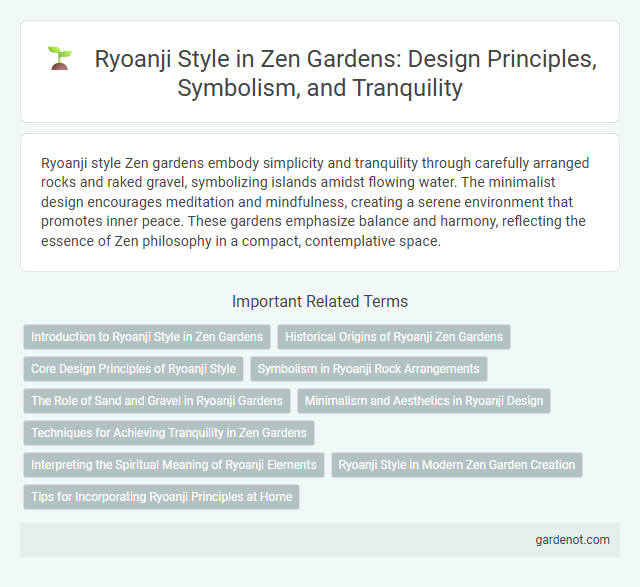Ryoanji style Zen gardens embody simplicity and tranquility through carefully arranged rocks and raked gravel, symbolizing islands amidst flowing water. The minimalist design encourages meditation and mindfulness, creating a serene environment that promotes inner peace. These gardens emphasize balance and harmony, reflecting the essence of Zen philosophy in a compact, contemplative space.
Introduction to Ryoanji Style in Zen Gardens
Ryoanji style in Zen gardens exemplifies minimalist design, featuring fifteen carefully placed rocks on a bed of white gravel representing islands in a sea. The arrangement avoids symmetry, encouraging contemplative meditation and introspection through simplicity and balance. This iconic style, originating from Kyoto's Ryoanji Temple, embodies the principles of wabi-sabi and promotes Zen mindfulness.
Historical Origins of Ryoanji Zen Gardens
Ryoanji Zen Gardens originated in 15th-century Kyoto, Japan, during the Muromachi period, embodying Zen Buddhist principles of simplicity and meditation. The garden's design features fifteen carefully placed stones symbolizing islands in an ocean, intentionally arranged so only fourteen are visible at once, reflecting the impermanence and mystery central to Zen philosophy. This historical garden served as a contemplative space for monks, influencing subsequent Japanese rock garden designs worldwide.
Core Design Principles of Ryoanji Style
Ryoanji style Zen gardens emphasize simplicity, asymmetry, and naturalness, creating a minimalist landscape that evokes tranquility and contemplation. The core design principles include the use of fifteen carefully arranged rocks symbolizing islands or mountains, surrounded by raked white gravel representing water or clouds, fostering a harmonious balance between emptiness and form. This style avoids ornamentation, focusing on subtle textures and spatial relationships to encourage mindfulness and introspection.
Symbolism in Ryoanji Rock Arrangements
Ryoanji rock arrangements symbolize Zen principles through minimalism and asymmetry, representing the essence of nature and the universe. Each carefully placed stone evokes harmony, balance, and the void, inviting meditation on impermanence and tranquility. The arrangement's abstract form encourages personal interpretation, reflecting the Zen teaching of experiential insight beyond literal meaning.
The Role of Sand and Gravel in Ryoanji Gardens
Sand and gravel in Ryoanji gardens serve as symbolic elements representing water and emptiness, creating a meditative landscape that encourages contemplation. The carefully raked patterns mimic the flow of rivers and waves, emphasizing harmony and tranquility within the minimalist design. This use of sand and gravel enhances the garden's spiritual atmosphere and reflects Zen principles of simplicity and balance.
Minimalism and Aesthetics in Ryoanji Design
Ryoanji style emphasizes minimalism through sparse arrangements of carefully placed rocks and gravel, creating a tranquil, contemplative space that embodies simplicity and balance. The aesthetics focus on natural elements and asymmetrical compositions, encouraging viewers to find harmony in imperfection and emptiness. This design philosophy reflects Zen principles, promoting mindfulness and deep reflection within the garden's serene environment.
Techniques for Achieving Tranquility in Zen Gardens
Ryoanji-style Zen gardens utilize carefully raked gravel patterns and asymmetrically placed rocks to evoke a sense of natural balance and calm. The minimalist design emphasizes empty space, allowing the mind to quiet and focus on simplicity. Techniques like selective pruning and moss placement enhance visual harmony, promoting deep contemplation and tranquility.
Interpreting the Spiritual Meaning of Ryoanji Elements
Ryoanji Zen garden elements symbolize the pursuit of enlightenment through simplicity and balance, with its fifteen stones arranged to evoke a meditative state while representing islands amid waves of white gravel. The asymmetrical composition encourages personal reflection, prompting viewers to explore inner harmony and the transient nature of existence. Each stone's placement and the raked gravel pattern embody Zen principles of impermanence, mindfulness, and the interconnectedness of life.
Ryoanji Style in Modern Zen Garden Creation
Ryoanji style emphasizes minimalist arrangement and precise placement of rocks within raked gravel to evoke tranquility and contemplation, making it a cornerstone in modern Zen garden creation. The integration of asymmetry, negative space, and natural elements mirrors ancient Japanese aesthetics while adapting to contemporary design principles. This approach fosters a meditative atmosphere that enhances spiritual reflection and harmony in urban landscapes.
Tips for Incorporating Ryoanji Principles at Home
Incorporate Ryoanji principles at home by designing a minimalist rock garden that emphasizes simplicity and tranquility, using carefully placed stones and raked gravel to evoke natural landscapes. Opt for asymmetrical arrangements to create balance through emptiness, encouraging meditation and mindfulness. Choose natural materials and maintain clean, uncluttered spaces to reflect Zen aesthetics and promote serenity.
Ryoanji style Infographic

 gardenot.com
gardenot.com